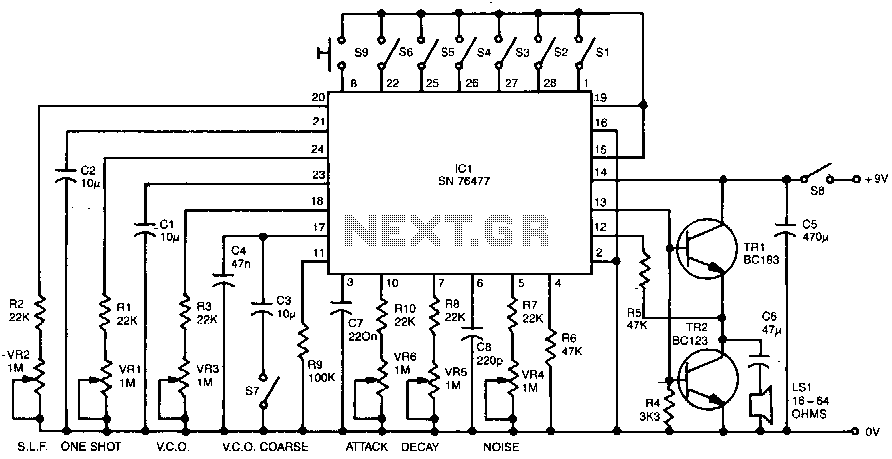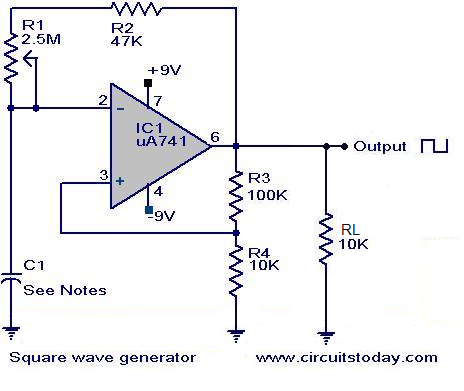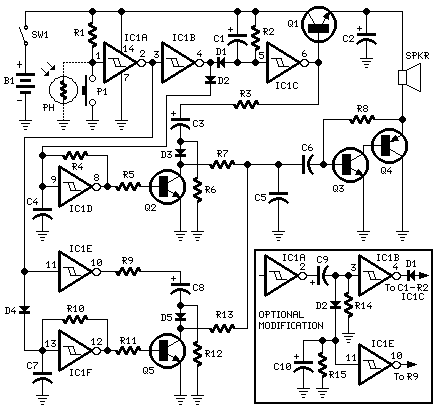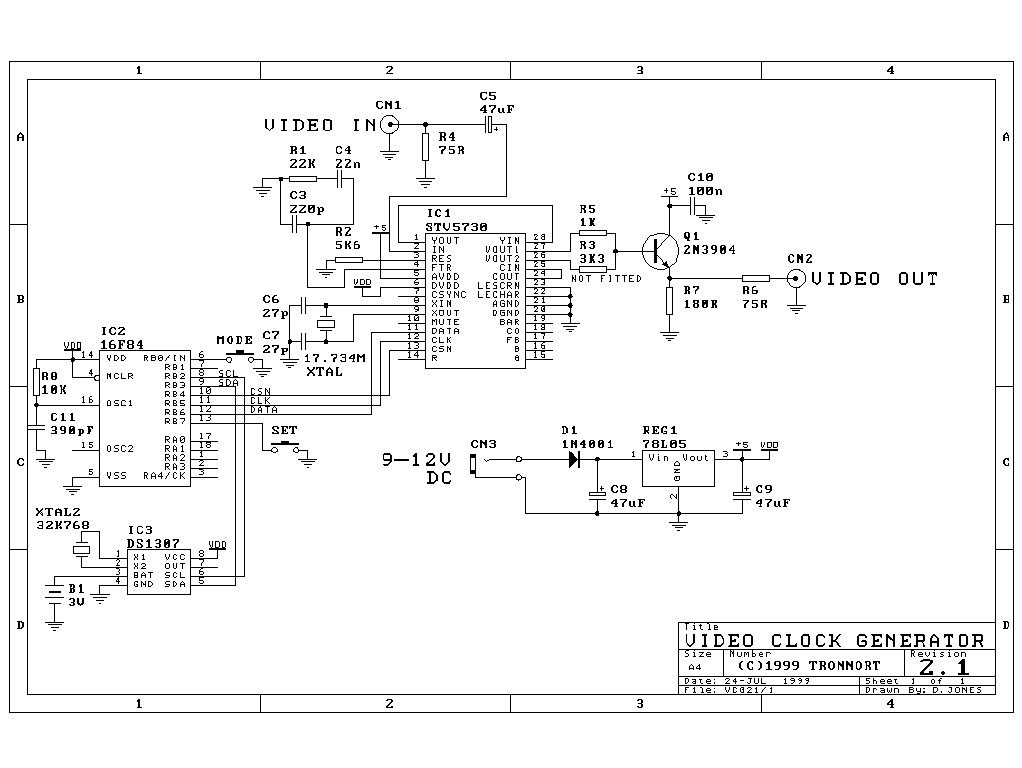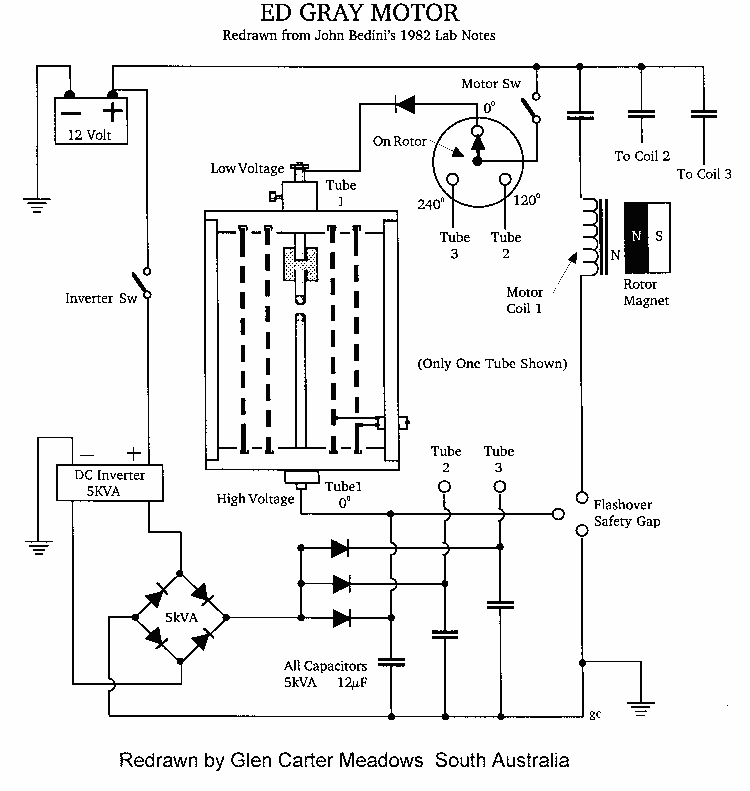
Pseudorandom-Sequential Ring-Modulated Tone Generator
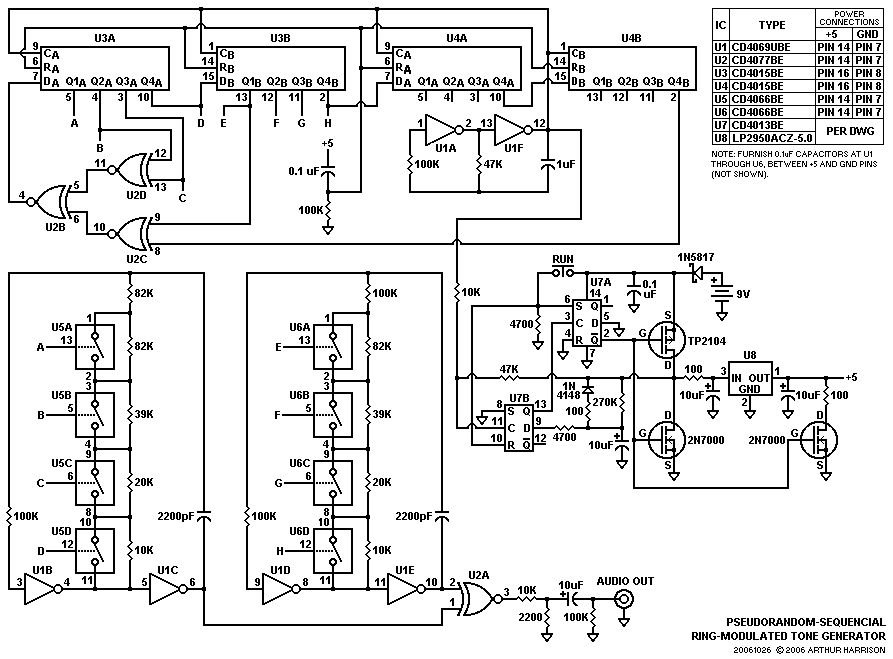
The circuit illustrated produces a brief sequence of rapidly alternating tones, reminiscent of the sounds associated with advanced computers, often featured in science fiction. This circuit was designed for the composition "Be Quite Still" by the band "The Cassettes." A similar sound was generated using a Moog Rogue analog synthesizer for the band's studio recording, but dedicating the synthesizer solely to this short effect would have limited its use for other parts of the live performance. The circuit consists of a 16-bit serial shift register (U3 and U4), which is clocked by a multivibrator (U1A-U1F) and utilizes data feedback through three exclusive-NOR gates (U2B, C, and D). This configuration creates a digital word generator that propagates pseudorandom data through the register, with the first four bits controlling the frequency of an audio oscillator made up of inverters (U1B-U1C) and a quad analog switch (U5). The fifth to eighth bits control a second audio oscillator (U1D-U1E and U6). The outputs of the two square wave oscillators are combined in an exclusive-NOR gate (U2A), functioning similarly to a ring-connected diode mixer, to produce sum and difference frequencies that yield harmonically complex tones at the AUDIO OUT jack. Flip-flops (U7A and U7B), a voltage regulator (U8), and associated components form a power-control circuit that supplies voltage to the tone generator for approximately two seconds, with the duration adjustable by changing a 270K resistor. U7B ensures the circuit powers down after the final tone, eliminating any undesirable silence at the end of the effect. To create a wide variety of tone pairs, the two square wave oscillators are offset in frequency by using an 82K resistor in one and a 100K resistor in the other. A momentary closure of the RUN switch initiates a two-second sequence, which can be extended if the switch is held down. Given the extensive length of the generated code and the 256 possible square wave pairs, the circuit can produce a lengthy sequence before repeating. The use of CMOS devices in the power control section negates the need for an on-off switch, as standby current is negligible. The circuit operates at less than 3 milliamperes, ensuring long battery life. A 1N5817 Schottky rectifier protects the CMOS devices from damage due to accidental battery reversal. It is advisable to maintain the specified allocation for the U1 inverter sections "A" through "F," as rearranging them could induce coupling between the audio oscillators, resulting in phase-locking and producing "dead" tone intervals. An audio sample of this circuit's output is available for reference.
The circuit design employs a 16-bit serial shift register, which is essential for generating a series of pseudorandom tones. The clocking mechanism provided by the multivibrator ensures that the data is shifted through the register at a consistent rate, allowing for rapid tone generation. The use of exclusive-NOR gates for data feedback is crucial, as it facilitates the creation of complex waveforms by mixing the outputs of the two oscillators. The interaction between the two oscillators, controlled by different bits from the shift register, allows for a rich variety of tones that can be produced.
The audio oscillators utilize inverters and an analog switch to create square wave outputs, which are then mixed to generate a more complex audio signal. The careful selection of resistors to offset the frequencies of the oscillators is instrumental in achieving a broad spectrum of tones. The ability to adjust the duration of the output sequence provides flexibility for live performances, allowing the musician to tailor the effect to suit the context of the music.
The power management aspect of the circuit is designed to be efficient, utilizing CMOS technology to minimize power consumption. This is particularly advantageous for battery-operated devices, as it extends operational time significantly. The inclusion of a Schottky rectifier not only protects the circuit but also ensures reliability during use.
Overall, this circuit exemplifies a sophisticated approach to sound generation, combining digital and analog techniques to produce unique audio effects suitable for a variety of applications, particularly in musical compositions and performances.The circuit illustrated produces a short duration of rapidly-sequencing tones, invoking the stereotypical sonic imagery of a sophisticated computer, such as would be scripted for the science-fiction genre. I designed this circuit for use in the composition "Be Quite Still, " by the popular band, "The Cassettes.
" A similar riff had been provided by a Moog Rogue analog synthesizer for the band`s studio recording, but dedicating the synthesizer to just this brief effect, alone, would have prevented its use for other parts of the composition in live peformances. The circuit is comprised of a 16-bit serial shift register (U3 and U4), clocked by multivibrator U1A-U1F, and employing data feedback via three exclusive-nor gates, U2B, C, and D.
This implements a digital word generator that propagates pseudorandom data through the register, of which the first four bits are used to control the frequency of an audio oscillator, comprised of inverters U1B-U1C and quad analog switch U5. Similarly, bits 5 through 8 control a second audio oscillator, comprised of U1D-U1E and U6. The two squarewave oscillator outputs are fed to exclusive-nor gate U2A, which combines them in a manner similar to a ring-connected diode mixer, producing sum and difference frequencies of the two squarewaves, resulting in harmonically-complex tones at the AUDIO OUT jack.
Flip-flops U7A and U7B, voltage regulator U8, and associated components form a power-control circuit that provides voltage to the tone generator for a duration of about two seconds. The duration is adjustable by varying the 270K resistor. U7B ensures that the circuit turns off after the last tone is completed, thus preventing the annoyance of a short interval at the end of the effect.
To provide a large variety of tone pairs, the two squarewave oscillators are offset in frequency by using an 82K resistor in one, and a 100K resistor in the other. A momentary closure of the RUN switch will initiate atwo-second sequence. If the switch is held closed for a longer period, the sequence will continue while the switch is held, and end as soon as the switch is released.
Given the considerable length of the generated code, and the 256 possible squarewave pairs, the circuit will produce an extremely long sequence before repeating. The use of CMOS devices in the power control section eliminates the need for an on-off switch, since standby current is essentially zero.
The circuit consumes less than 3 milliamperes while operating, providing extensive battery life. The 1N5817 Schottky rectifier prevents damage to the CMOS devices in the event of accidental battery reversal. In constructing this circuit, it is recommended that the U1 inverter sections "A" through "F" are allocated exactly as shown, since rearranging the otherwise-identical sections may cause sufficient coupling between the two audio oscillators for phase-locking, evident as "dead" tone intervals.
Click here for an audio sample of this circuit`s output. 🔗 External reference
The circuit design employs a 16-bit serial shift register, which is essential for generating a series of pseudorandom tones. The clocking mechanism provided by the multivibrator ensures that the data is shifted through the register at a consistent rate, allowing for rapid tone generation. The use of exclusive-NOR gates for data feedback is crucial, as it facilitates the creation of complex waveforms by mixing the outputs of the two oscillators. The interaction between the two oscillators, controlled by different bits from the shift register, allows for a rich variety of tones that can be produced.
The audio oscillators utilize inverters and an analog switch to create square wave outputs, which are then mixed to generate a more complex audio signal. The careful selection of resistors to offset the frequencies of the oscillators is instrumental in achieving a broad spectrum of tones. The ability to adjust the duration of the output sequence provides flexibility for live performances, allowing the musician to tailor the effect to suit the context of the music.
The power management aspect of the circuit is designed to be efficient, utilizing CMOS technology to minimize power consumption. This is particularly advantageous for battery-operated devices, as it extends operational time significantly. The inclusion of a Schottky rectifier not only protects the circuit but also ensures reliability during use.
Overall, this circuit exemplifies a sophisticated approach to sound generation, combining digital and analog techniques to produce unique audio effects suitable for a variety of applications, particularly in musical compositions and performances.The circuit illustrated produces a short duration of rapidly-sequencing tones, invoking the stereotypical sonic imagery of a sophisticated computer, such as would be scripted for the science-fiction genre. I designed this circuit for use in the composition "Be Quite Still, " by the popular band, "The Cassettes.
" A similar riff had been provided by a Moog Rogue analog synthesizer for the band`s studio recording, but dedicating the synthesizer to just this brief effect, alone, would have prevented its use for other parts of the composition in live peformances. The circuit is comprised of a 16-bit serial shift register (U3 and U4), clocked by multivibrator U1A-U1F, and employing data feedback via three exclusive-nor gates, U2B, C, and D.
This implements a digital word generator that propagates pseudorandom data through the register, of which the first four bits are used to control the frequency of an audio oscillator, comprised of inverters U1B-U1C and quad analog switch U5. Similarly, bits 5 through 8 control a second audio oscillator, comprised of U1D-U1E and U6. The two squarewave oscillator outputs are fed to exclusive-nor gate U2A, which combines them in a manner similar to a ring-connected diode mixer, producing sum and difference frequencies of the two squarewaves, resulting in harmonically-complex tones at the AUDIO OUT jack.
Flip-flops U7A and U7B, voltage regulator U8, and associated components form a power-control circuit that provides voltage to the tone generator for a duration of about two seconds. The duration is adjustable by varying the 270K resistor. U7B ensures that the circuit turns off after the last tone is completed, thus preventing the annoyance of a short interval at the end of the effect.
To provide a large variety of tone pairs, the two squarewave oscillators are offset in frequency by using an 82K resistor in one, and a 100K resistor in the other. A momentary closure of the RUN switch will initiate atwo-second sequence. If the switch is held closed for a longer period, the sequence will continue while the switch is held, and end as soon as the switch is released.
Given the considerable length of the generated code, and the 256 possible squarewave pairs, the circuit will produce an extremely long sequence before repeating. The use of CMOS devices in the power control section eliminates the need for an on-off switch, since standby current is essentially zero.
The circuit consumes less than 3 milliamperes while operating, providing extensive battery life. The 1N5817 Schottky rectifier prevents damage to the CMOS devices in the event of accidental battery reversal. In constructing this circuit, it is recommended that the U1 inverter sections "A" through "F" are allocated exactly as shown, since rearranging the otherwise-identical sections may cause sufficient coupling between the two audio oscillators for phase-locking, evident as "dead" tone intervals.
Click here for an audio sample of this circuit`s output. 🔗 External reference
